
Crystal Lake Reservoir
Crystal Lake Reservoir is the last reservoir in the series (fig.
2D). During the period of this study, water flowed via Middle Crow Creek and a pipeline from Granite Springs Reservoir into Crystal Lake Reservoir. At 6,969 ft, Crystal Lake has the lowest spillway elevation of the four reservoirs. The reservoir contains about 8 percent of the system storage and is about 65 ft deep
(table 1). It is located in an open forest and grassland area, and is popular for recreational activities such as boating, fishing, and camping.
Profile data indicate that stratification occurs in Crystal Lake during the warmer months. The September 4, 1997 profiles of Crystal Lake (fig. 19A) show stratification of dissolved oxygen and pH in the reservoir. Water temperature, dissolved oxygen, specific conductance, and pH were essentially constant in the
epilimnion. Temperature was constant to about 17 ft. The dissolved-oxygen concentration was 6.3 mg/L and 86 percent of saturation at a depth of 1 ft. The
dissolved-oxygen concentrations decreased to less than 5 mg/L in the metalimnion. A minimum dissolved-oxygen concentration of 5 mg/L generally has been suggested for the protection of cold-water fish. Water temperature and pH also decreased in the
metalimnion, which extended from about 16 ft to about 26 ft below the surface. The euphotic zone extended to about the bottom of the
metalimnion, based on a Secchi disk transparency of 7.7 ft. In the hypolimnion, dissolved-oxygen concentrations continued to decrease (fig. 19A). The dissolved-oxygen concentration was about 1.3 mg/L at about 44 ft and was only 17 percent of saturation. This concentration was less than the concentration generally suggested for the protection of warm-water fish. Specific conductance increased with depth in the
hypolimnion, from about 109 to 115 µS/cm.
The February 3, 1998 winter profiles (fig. 19B) show a general lack of stratification of the water in Crystal Lake. On February 3, the reservoir was covered with about 1 ft of very clear ice with virtually no snow cover. The clear ice apparently allowed enough light for photosynthesis by the phytoplankton, as indicated by the dissolved-oxygen concentration of 14.7 mg/L, or 134 percent of saturation, at a depth of 1 ft below the ice. The water temperature at 1 ft beneath the water surface was 1.0°C; below that depth the temperature, ranged between 3 and 4°C. This temperature pattern, typical of temperate lakes, was expected because water at its maximum density is at about 4°C. From 2 ft to about 50 ft below the surface, the profiles show little variation. Below 50 ft, small changes in pH and specific conductance were noted.
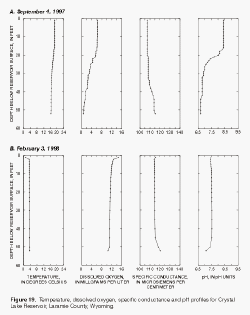
Figure 19. Temperature, dissolved oxygen, specific conductance,
and pH profiles for Crystal Lake Reservoir, Laramie County, Wyoming.
(Click on image for a larger version, 26kb) |
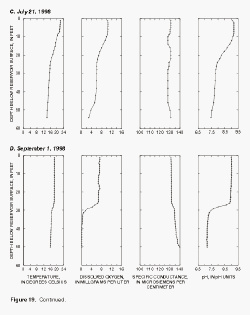
Figure 19. Continued.
(Click on image for a larger version, 25kb) |
The July 21, 1998 profile data indicate weak stratification (fig. 19C). The epilimnion extended to about 10 ft, the metalimnion from about 10 to 24 ft, and the hypolimnion from about 24 ft to the bottom. Temperatures ranged from 22 to 20°C in the
epilimnion, decreased from 20 to 16°C through the metalimnion, and ranged from 16 to 14°C in the
hypolimnion. Dissolved-oxygen concentrations were near 10 mg/L to a depth of about 9 ft. Concentrations then decreased to 5.6 mg/L at about 24 ft. In the
hypolimnion, dissolved-oxygen concentrations were essentially stable to about 42 ft, then decreased to 1.9 mg/L near the bottom.
By September 1, 1998, profiles indicate that stratification had reached much deeper into the reservoir with the epilimnion extending down to nearly 30 feet (fig. 19D). Dissolved-oxygen concentrations and pH showed sharp changes between about 26 ft and 31 ft. Dissolved oxygen ranged from 7.3 to 6.4 mg/L from the surface to 26 ft; concentrations then decreased to less than 1 mg/L by 31 ft and were less than 1 mg/L throughout the
hypolimnion. The pH was fairly constant down to about 26 ft, about 9.0. In the
metalimnion, the pH decreased from 8.9 to 7.3. The pH remained around 7.2 to 7.3 throughout the
hypolimnion. From about 26 ft, specific conductance increased in the
metalimnion. Specific conductance continued to gradually increase with depth in the
hypolimnion.
Temperature and dissolved oxygen in Crystal Lake were measured between May and October, 1998. In mid-May, the reservoir showed a relatively uniform temperature profile, ranging between 5 and 10°C (fig. 20). Throughout May and June, the reservoir warmed and began to stratify. By mid-July, the reservoir was stratified and the surface-water temperature was slightly higher than 20°C. The water cooled throughout the fall, and by early October 1998 the water was relatively uniform in comparison to the summer profiles. Dissolved-oxygen concentrations (fig. 21) during May and June 1998 ranged from 5 to 10 mg/L. However, in mid-July a zone of dissolved oxygen in the upper 10 ft of the lake was higher than 10 mg/L.
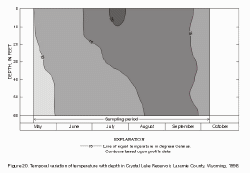
Figure 20. Temporal variation of temperature with depth in
Crystal Lake Reservoir, Laramie County Wyoming.
(Click on imager for a larger version, 12kb) |
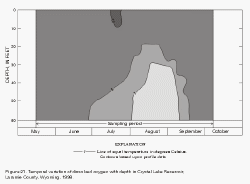
Figure 21. Temporal variation of dissolved oxygen with depth
in Crystal Lake Reservoir, Laramie County Wyoming.
(Click on imager for a larger version, 12kb) |
From late-June until mid-September, a dissolved oxygen zone of less than 5 mg/L developed near the bottom of the reservoir. By August, the zone had expanded and concentrations were less than 1 mg/L. The multiparameter probes used in this study do not accurately measure oxygen concentrations below
1 mg/L. By mid-August, dissolved-oxygen concentrations of 1 mg/L or less extended about 30 ft above the bottom of the reservoir. As oxygen concentrations approach zero, many trace elements become more soluble and may move into the water column from the sediment. An increase in manganese concentration is sometimes observed in the raw water at the water treatment facilities. A possible explanation could be anoxic conditions of the lower part of the reservoir, which allows the manganese to become more soluble.
Blue-green algae and diatoms dominated the phytoplankton community of Crystal Lake. Other divisions, such as the green algae and the
cryptomonads, were present in the samples, but each constituted less than 25 percent of the total biomass (fig. 22).
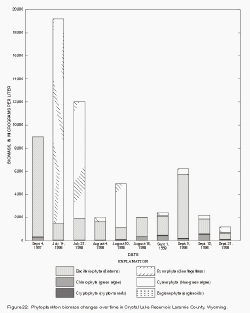
Figure 22. Phytoplankton biomass changes over time in Crystal
Lake Reservoir, Laramie County, Wyoming.
(Click on imager for a larger version, 18kb) |
Of the 42 algal taxa identified, only 5 taxa were blue-green algae. Nonetheless, the blue-green algae
Anabaena
dominated the phytoplankton community in the July 14, July 21, and August 10, 1998 samples
(Appendix B, table B4; fig. 22).
Anabaena
reached a maximum concentration of 18,000 µg/L biomass (29,100 cells/mL density) in the July 14 sample.
Anabaena
also was the most common of the blue-green algae present in the samples collected on September 9, 15, and 21, 1998. Diatoms, particularly
Fragilaria
, were the dominant algae in the remainder of the samples (fig. 22). The peak mass of
Fragilaria
was 6,500 µg/L (4,490 cells/mL) in the September 4, 1997 sample. The diatoms
Stephanodiscus
and
Cyclotella
were subdominants in some of the samples;
Stephanodiscus
predominated in the September 9 sample. A total of 17 taxa of green algae were identified, but none was dominant. The most common taxa of green algae were
Staurastrum
and
Cosmarium
. |
Samples were collected 1 foot below the surface and 3 ft above the lake bottom on September 4, 1997. The total phytoplankton biomass of the deep sample was 2,000 µg/L, compared to 9,000 in the near-surface sample. The diatom
Fragilaria
was the predominant alga in both samples. A phytoplankton sample was collected at a depth of about 30 ft, within the
metalimnion, on September 11, 1997; the diatom
Fragilaria
predominated in the sample. The total phytoplankton mass in the sample collected at 30 ft was 4,900 µg/L.
The concentration of Protozoa in samples from Crystal Lake typically was less than 100 µg/L. Some samples had higher concentrations; for example, September 9 sample had a concentration of ciliates of 670 µs/L.
In Crystal Lake in the fall of 1997, MPA was dominated by non-diatomaceous phytoplankton and diatoms. MPA results are summarized in
table 5.
Three samples were collected for chemical analysis at Crystal Lake: a surface sample, a sample at 30-ft below the lake surface, (hereafter referred to as the middle sample), and a bottom sample. The depth for the middle sample was selected based on the estimated
pipeline intake level for the water treatment plants. The dissolved-solids concentrations of 58 mg/L for the surface sample, 60 mg/L for the middle sample, and 63 mg/L for the bottom sample
(table 2; fig.
7) indicate relatively little difference between the three samples, with a possible slight increase toward the reservoir bottom. The water was a calcium-bicarbonate type. No differences were apparent in the percentages of major ions between samples collected from the top, middle, and bottom of the reservoir
(fig. 8). Dissolved-fluoride concentrations were 0.5 mg/L in all three samples.
Silica concentrations, as dissolved SiO2, increased from 2.1 to 6.4 mg/L with depth
(table 2; fig.
9). Nutrient concentrations were less than the detection level in all samples except two. In the sample at 30 ft, dissolved nitrogen as ammonia was 0.09 mg/L, and in the bottom sample nitrogen as ammonia was 0.14 mg/L. Dissolved-iron concentrations were slightly higher in the middle and bottom samples than in the surface sample
(fig. 10). Dissolved-manganese concentrations increased from <1 µg/L in the surface to 31 µg/L in the bottom sample
(fig. 11).
Because water is diverted from Crystal Lake to the treatment plants, analyses also were completed for 4 radionuclides and 48 organic compounds. Two radionuclides and two organic compounds were detected; all others were less than the detection limit. Alpha (Th-230 and beta (CS-137) emission were the radionuclides detected. Metolachlor and atrazine were detected, but the low concentrations were estimated. Metholachlor was detected only in the surface sample at a concentration estimated to be slightly greater than the detection limit. Results are summarized in table 6.
On February 3, 1998, bottom-sediment samples were collected at five sites in Crystal Lake
(fig. 2D). The samples were composited into a single sample. The concentrations of selected constituents analyzed in
in that sample are listed in table 3. Of the constituents analyzed, aluminum concentration was highest at 6.8 percent, iron was 3.6 percent, and potassium was 2.7
percent.
Table 6. Concentrations of selected radionuclide activities and organic compounds in water-quality samples collected September 4, 1997, at Crystal Lake Reservoir, Laramie County, Wyoming.
[Surface sample collected 1 foot below reservoir
surface; bottom sample collected 3 feet above reservoir bottom; est, estimated;
pCi/L, picocuries per liter; µg/L, micrograms per liter; concentrations are
dissolved unless otherwise noted]
|
Parameter/compound
|
Surface sample (µg/L, except
as noted)
|
Bottom sample (µg/L, except
as noted)
|
|
Gross beta, dissolved as Cs-137
|
<4.0.pCi/L
|
<4.0.pCi/L
|
|
Propachlor,
|
<.007
|
<.007
|
|
Butylate
|
<.002
|
<.002
|
|
Simazine
|
<.005
|
<.005
|
|
Prometon
|
<.018
|
<.018
|
|
Des-ethylatrazine,
|
<.002
|
<.002
|
|
Cyanazine
|
<.004
|
<.004
|
|
Fonofox
|
<.003
|
<.003
|
|
Alpha, dissolved as Th-230
|
<3.0.pCi/L
|
<3.0.pCi/L
|
|
Phenols, total
|
<1
|
<1.
|
|
Alpha BHC
|
<.002
|
<.002
|
|
p,p' DDE
|
<.006
|
<.006
|
|
Chlorpyrifos
|
<.004
|
<.004
|
|
Lindane
|
<.004
|
<.004
|
|
Dieldrin
|
<.001
|
<.001
|
|
Metolachlor
|
.002 est.
|
<.002
|
|
Malathion
|
<.005
|
<.005
|
|
Parathion
|
<.004
|
<.004
|
|
Diazinon
|
<.002
|
<.002
|
|
Atrazine
|
.0028 est.
|
.0029 est.
|
|
Alachlor
|
<.002
|
<.002
|
|
Acetochlor
|
<.002
|
<.002
|
|
Alpha, pe Th-230
|
.56.pCi/L
|
.41 pCi/L
|
|
Beta, pe Cs-137
|
1.95.pCi/L
|
1.97.pCi/L
|
|
Metribuzin
|
<.004
|
<.004
|
|
2,6-Diethylaniline
|
<0.003
|
<0.003
|
|
Trifluralin
|
<.002
|
<.002
|
|
Ethalfluralin
|
<.004
|
<.004
|
|
Phorate
|
<.002
|
<.002
|
|
Terbacil
|
<.007
|
<.007
|
|
Linuron
|
<.002
|
<.002
|
|
Methyl parathion
|
<.006
|
<.006
|
|
EPTC
|
<.002
|
<.002
|
|
Pebulate
|
<.004
|
<.004
|
|
Tebuthiuron
|
<.01
|
<.01
|
|
Molinate
|
<.004
|
<.004
|
|
Ethoprop
|
<.003
|
<.003
|
|
Benfluralin
|
<.002
|
<.002
|
|
Carbofuran
|
<.003
|
<.003
|
|
Terbufos
|
<.013
|
<.013
|
|
Pronamide
|
<.003
|
<.003
|
|
Disulfoton
|
<.017
|
<.017
|
|
Triallate
|
<.001
|
<.001
|
|
Propanil
|
<.004
|
<.004
|
|
Carbaryl
|
<.003
|
<.003
|
|
Thiobencarb
|
<.002
|
<.002
|
|
DCPA
|
<.002
|
<.002
|
|
Pendimethalin
|
<.004
|
<.004
|
|
Napropamide
|
<.003
|
<.003
|
|
Propargite
|
<.04
|
<.013
|
|
Methyl azinphos
|
<.001
|
<.001
|
|
cis-Permethrin
|
<.005
|
<.005
|
Most of the trace-element concentrations are in the microgram-per-gram range.
Concentrations of nitrogen, (nitrite plus nitrate), arsenic, bismuth, cadmium,
gold, holmium, molybdenum, silver, tantalum, tin, and uranium were less than the
detection limit. Concentrations of thorium, vanadium, cerium and chromium are
plotted in figure 12. The trace-element concentrations fit best in Group 2--more
like granitic rocks than either diabase or the crustal average. This similarity
is probably due to the extensive exposures of Sherman Granite (Precambrian)
within the drainage area of the reservoir.
[Table of Contents] [Abstract]
[Introduction]
[Rob Roy Reservoir]
[Lake Owen]
[Granite Springs
Reservoir] [Crystal Lake Reservoir]
[Summary]
[Appendix A]
[Appendix B]




